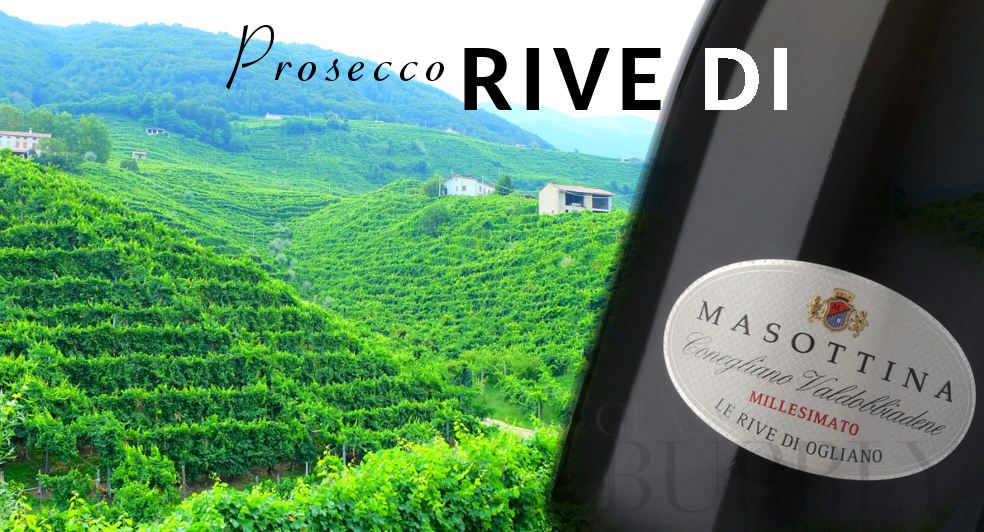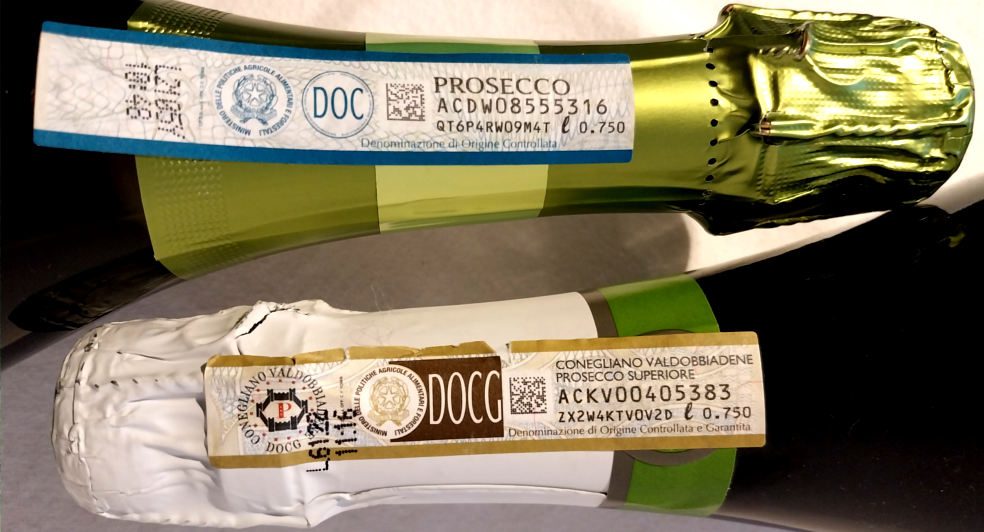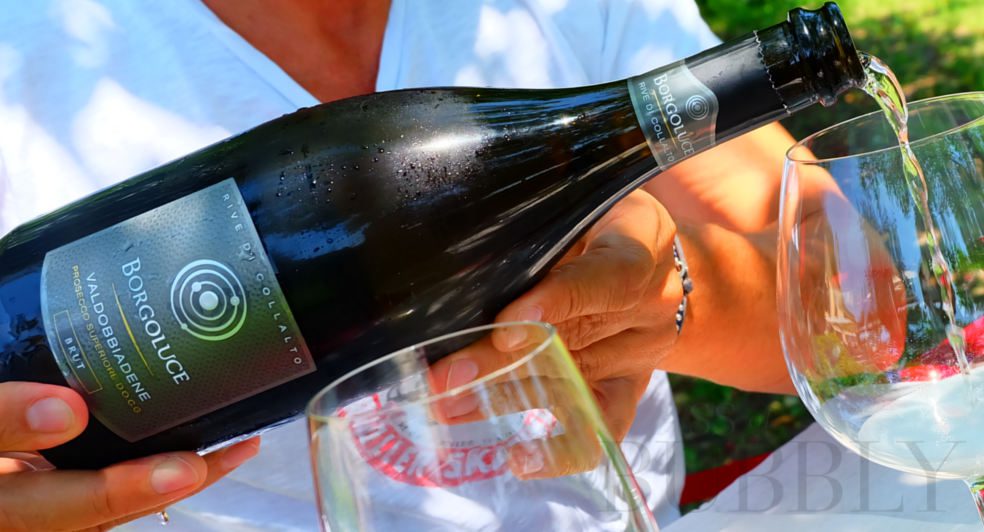What is Prosecco DOCG Rive?
3rd March 2023

Many will assume, and rightly so I guess, that the quality of wines depends on the prices they are set at. If you have ever visited a restaurant and looked at the wine list, they are usually in price order which dictates the order of quality, right? A glass of Prosecco is a glass of Prosecco is it not? Or is there something more we should know… ?
Wines are indeed very much classified by their value, though those of us a little more engrossed in the topic of wine will see ratings more on their qualities and exclusivity.
“When it comes to Prosecco, head for the hills! ” Christopher Walkey
Even Prosecco has quality levels and should not be mistaken as just a cheap way to enjoy bubbles in your glass. Over the last few years Prosecco sales in the UK have skyrocketed with the popular Italian fizz becoming a firm favourite for consumers as an economical choice when it comes to sparkling wine. Many supermarkets will have a Prosecco displayed at the end of an isle on promotion usually from £5.99 onwards and, along with the incredible marketing to make it a trending wine option, it has fallen in to the baskets and trolleys of many weekly shoppers.
Yes, Prosecco just like many other wines, comes in different quality levels with the basic format to understand being DOC and DOCG.
DOC: The standard / entry level quality of Prosecco with mass produced regions of easy to manage vineyards. Recognised by a blue classification strip on the neck of the bottle.
DOCG: The superior quality of Prosecco with selected vineyards in the best quality producing regions, all grapes hand picked. Recognised by a brown/gold classification strip on the neck of the bottle.

DOC Blue label – DOCG Brown Gold label
Once we realise the two main classifications of qualities in Prosecco, we can look at the categories* in each:
DOC – Prosecco: DOC Prosecco is grown on the flat Vineyards of Prosecco (as of 2020 Prosecco DOC had 24,450 hectares of vineyards with 1,169 winemakers and 347 Prosecco houses).
DOC – Prosecco Trieste: Production is within smaller designated regions with more (quality) control in place.
DOC – Prosecco Treviso: Production is within smaller designated regions with more (quality) control in place.
DOC – Prosecco Rosé: Available under DOC classification only (as of 2020 – 2023).
DOCG – Prosecco Valdobbiadene Superiore: All DOCG Prosecco is produced from grapes grown on hillside Vineyards and are only handpicked, this area is between Valdobbiadene and Conegliano
DOCG – Asolo Prosecco Superiore: Considered to contain a finer terroir to grow grapes.
DOCG – Prosecco Valdobbiadene Superiore Rive: Only 43 communes can be labelled as such.
DOCG – Prosecco Superiore di Cartizze: Only 265 acres are within the Cartizze area, it is considered the best terroir in the Prosecco Region, in Valdobbiadene.

“Though I respectfully recognise that Cartizze is the finest production quality of Prosecco and most certainly it is a treasure in the world of wine tourism, there is another equally as special when it comes to Superiore and that’s ‘Rive’ labels. Some of the greatest Prosecco I have tasted come under this category especially the Brut and Extra Dry labels delivering bundles of Glera grape aromas and flavours in just the way I like them. Having visited the Prosecco region some near twenty times in recent years, I really appreciate the difference in classification regions and certainly the reasons why quality levels vary tremendously.” Christopher Walkey
Let us better understand what ‘Rive’ means in Prosecco classifications:
The term ‘Rive‘ refers to the ‘steep hills‘ in regards to those within the DOCG region / Conegliano Valdobbiadene. Each Rive delivers a unique expression of the hills of the region showcasing individual terroir ie; characters delivered by soil and microclimates.
There are in total 43 Rive Prosecco names to look out for with approximately 250 hectares dedicated to these areas. The classification is not overly known outside of Italy, especially in the UK market, and though the Rive area has a prestigious rating, if a winery chooses to mix a blend of more than one Rive commune then the rules say it can not be named as one. Rather like the exclusive area of Cartizze, the Rive communes allows for serious Prosecco lovers to explore production from unique terroirs. You can find Clos (walled / single vineyard) production at some Prosecco houses, though very few and very far between and certainly not as common as Clos labels in Champagne.
“The term “Rive” indicates, in the local way of speaking, the slopes of the steep hills that are characteristic of the zone. This category of wine highlights the diverse expressions of Conegliano Valdobbiadene. Rive wines are often obtained from the most precipitous, high-quality vineyards, from grapes grown in a single commune or area thereof, thus underlining the characteristics that a particular terroir gives to the wine. Within the denomination there are 43 Rive, and each one expresses a different and distinctive combination of soil, exposure and microclimate. In the Rive, yields are reduced to 13 tonnes of grapes per hectare, the grapes are picked exclusively by hand and the vintage is always shown on the label.” Conegliano Valdobbiadene DOCG website.
List of Rive Communes in Prosecco Region:
Municipality of Valdobbiadene
1 San Vito
2 Bigolino
3 San Giovanni
4 San Pietro di Barbozza
5 Santo Stefano
6 Guia
Municipality of Vidor
7 Vidor
8 Colbertaldo
Municipality of Miane
9 Miane
10 Combai
11 Campea
12 Premaor
Municipality of Farra di Soligo
13 Farra di Soligo
14 Col San Martino
15 Soligo
Municipality of Follina
16 Follina
17 Farro’
Municipality of Cison di Valmarino
18 Cison di Valmarino
19 Rolle
Municipality of Pieve di Soligo
20 Pieve di Soligo
21 Solighetto
Municipality of Refrontolo
22 Refrontolo
Municipality of San Pietro di Feletto
23 San Pietro di Feletto
24 Rua di Feletto
25 Santa Maria di Feletto
26 San Michele di Feletto
27 Bagnolo
Municipality of Tarzo
28 Tarzo
29 Resera
30 Arfanta
31 Corbanese
Municipality of Susegana
32 Susegana
33 Colfosco
34 Collalto
Municipality of Vittorio Veneto
35 Formeniga
36 Cozzuolo
37 Carpesica
38 Manzana
Municipality of Conegliano
39 Scomigo
40 Collalbrigo – Costa
41 Ogliano
Municipality of San Vendemiano
42 San Vendemiano
Municipality of Colle Umberto
43 Colle Umberto
(Thank you to Giulia from Prosecco.it for the list above – much appreciated!)
* We can also add Frizzante and Tranquillo (still wine) into annual Prosecco production though their numbers are very minor.
![]()
Christopher Walkey
Co-founder of Glass of Bubbly. Journalist and author focused on Champagne & Sparkling Wines and pairing them with foods.
